Predictions For Brand Building In 2023 And Beyond, By Ali Rezgui
Our business very much relies on spotting change, be it consumer behaviors, emerging platforms, evolving competitive landscape or even our own clients shifting expectations on what we should be delivering.

But predictions are always a delicate exercise and as stated by Roy Amara, a Stanford computer scientist, “We always overestimate the change that will occur in the short term and underestimate the change that will occur in the long term.”
And this tendency to overestimate short term change is very prevalent in advertising because this is supposedly the foundation of our expertise and added value, identifying the weak signals and connecting dots that others don’t even see to best future-proof brands in an ever-changing world.
That said, there might be some benefit reflecting on Bezos provocation to this topic of change.
“I very frequently get the question: ‘What’s going to change in the next 10 years?’ And it’s a very interesting question; it’s a very common one. I almost never get the question: ‘What’s not going to change in the next 10 years?’
And I submit to you that that second question is actually the more important of the two — because you can build a business strategy around the things that are stable in time”.
While it’s not really the most fashionable starting point in an industry that can easily get distracted by the new and the latest at the expense of the tried and true, it can be, more often than not, the most useful starting point for brand building.
With this in mind, below my predictions on 10 things I believe won’t change in 2023.
Metaverse (for whatever that really means) will continue being a fringe marketing activity where some select brands [especially in tech or luxury] will continue experimenting with niche audiences but it won’t really scale because the value prop for consumers is still quite shallow and monetization for brands even shallower. If in any doubt, just take a look at meta stock exchange trend.
Communities will still be mostly found in gaming [which is bigger than the movie and music industry combined] with its captive and engaged audience so more brands will try tapping into it and increase their spending and activities in this space. [through partnerships with platforms, gamers, services, etc.]. Burger king with its Stevenage activation on FIFA or Carrefour with its healthy map initiative on fortnight are good example of what can be done in the space.
Inflation will keep going up giving retailers an opportunity to become even closer to their consumers and keep building their own brands by leveraging first party data to drive more utility and relevance. Carrefour has already announced new initiatives to strengthen its own brands and give them more visibility which other retailers are likely to emulate.
Spending will experience a two speeds reality, brands that will reduce any type of brand building activities, focusing on the short term with rational / functional and promotional messages VS those that will see it as an opportunity to strengthen their brand equity and keep, if not even increase their marketing spending with more emotional, creative, fame worthy type of comms. In 2008 P&G doubled down on its spending with great results and they seem to follow the same blueprint today by investing behind their brand creativity.
Mainstream brands will be stuck in the middle between the accessible and the premium, with the need to fight harder to justify their value and we can expect a renewed focus on core reason to exist, either through very rational RTB or higher emotional play.
Cookieless edging closer and with tighter privacy policies from Apple, many brands will try accelerating their first party data collection by building their own ecosystem which will lead to more partnerships and acquisitions when lacking the capabilities or talents internally.
Social commerce will grow even bigger with the role of creators becoming more crucial for brands to tap into micro and macro communities as media is getting more expensive and fragmented. Asia is leading the way in this space and western brands should be well inspired to look a bit east.
Retail media will continue growing at an exponential rate as the pressure for short term sales becomes higher and the need to demonstrate ROI on each dollar invested keeps increasing with new opportunities for retailers and brands to partner closer.
Local will be the name of the game if many markets and for many brands as the post-covid world is more polarized, leading global brands to try and find ways to be culturally closer to their audiences by leveraging local specificities
Actions are what consumers, especially younger ones are increasingly expecting from brands, especially in a difficult economic context to fill the gaps left by governments shortcomings. Some brands will go beyond business as usual to play a bigger, more meaningful and positive societal role, somewhat similarly to how Heineken, Louis Vuitton or Mercedes stepped in and stepped up for the greater good during Covid, winning share of hearts and ultimately share of wallets.





